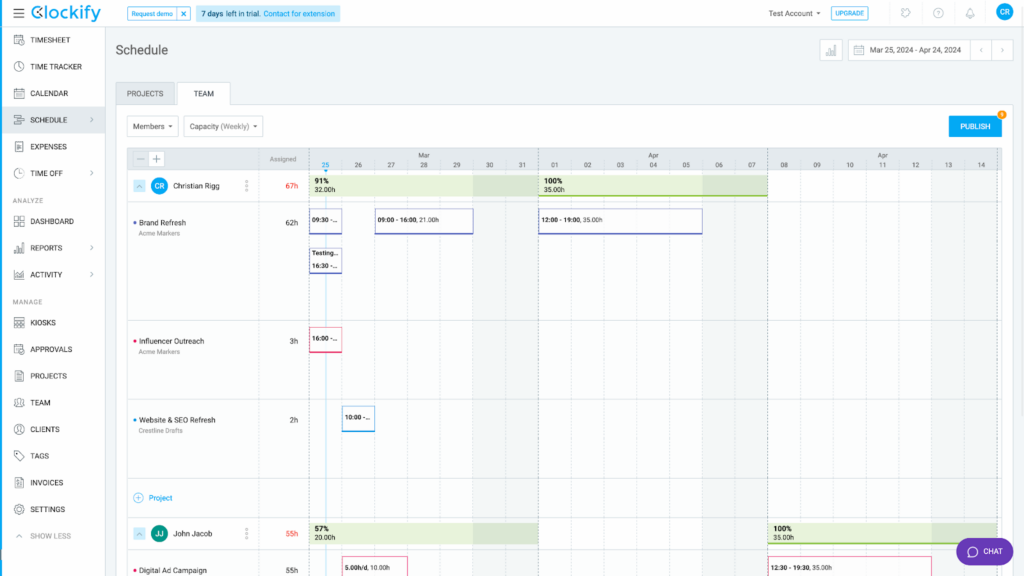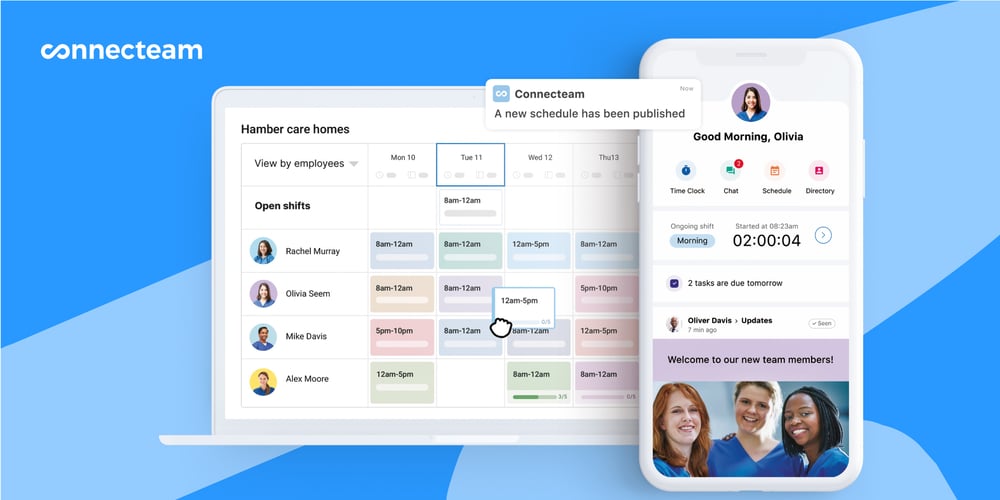While Clockify has a generous free plan and flexible project tracking for budget-conscious teams, Time Doctor offers in-depth employee monitoring and productivity analytics for businesses that require stringent oversight. Learn more in my detailed comparison of these leading time tracking solutions.
Managing teams outside traditional offices means tracking work hours for payroll, monitoring project progress, and keeping productivity high—all without micromanaging. The wrong employee tracking software can make these tasks even harder, leading to inaccurate pay, missed deadlines, and aggrieved employees.
Two leading time tracking solutions are Clockify and Time Doctor. Below, I compare their features, pricing, and ideal use cases to help you find the perfect match for your team’s particular needs.
A note about our method: All product comparisons and verdicts in this guide are based on hands-on testing by our expert team. Every screenshot was taken from real use during our evaluation.
At a Glance: Quick Summary
Clockify is a flexible time tracking tool that immediately gets attention for its generous free plan that supports unlimited users and projects. It was made for businesses that need to track time against specific projects and tasks for billing and analysis, but it lacks the advanced productivity monitoring features Time Doctor offers.
Time Doctor is built for businesses that need to closely monitor the productivity of remote or hybrid teams. It offers screenshotting, web and app usage tracking, and activity-level monitoring to provide a detailed picture of how desk-based work gets done. While powerful for ensuring accountability, I feel it can be seen as invasive by staff, making it a better fit for companies where detailed proof of work is a real priority.
Neither platform is a great choice for field-based teams.
Pricing and Plans
Clockify provides a free entry point for teams of any size. Time Doctor skips the free plan and focuses on paid tiers that deliver monitoring tools from the start.
| Plan Type | Clockify | Time Doctor – Monthly/User |
| Free Plan | $0 for unlimited users | ❌ |
| Starter | Basic $3.99/user/month Includes time tracking, basic reports, unlimited projects, and timesheet management | Basic $6.70/user/month Includes time tracking, screenshots, activity monitoring, and basic reporting |
| Standard | Standard $5.49/user/month Adds time off, approvals, overtime, invoicing, and more | Standard $11.70/user/month Adds scheduling, time approvals, time off and break tracking, and more |
| Pro/Premium | Pro $7.99/user/month Adds scheduling, GPS tracking, expense tracking, advanced reporting, and more | Premium $16.70/user/month Adds video recording, productivity ratings, payroll features, and 60+ integrations |
| Enterprise | Enterprise $11.99/user/month Includes single sign-on, custom subdomain, advanced admin controls, and more | Enterprise Custom pricing Adds option for private cloud deployment and customizable BI dashboards |
| * All prices show the monthly cost when billed annually as of August 2025. | ||
Clockify offers great value with its free plan, which includes unlimited time tracking, unlimited projects, and basic reporting for any number of users. Its paid plans progressively add more administrative and project management features, like scheduling and expense tracking. This structure allows you to start for free and scale up as your needs become more complex.
I think Time Doctor is better suited for businesses ready to invest in productivity analytics from day one. It offers a 14-day free trial to test its premium features. Its plans are built around delivering detailed workforce insights, with features like web and app usage reporting and productivity ratings available in its Standard plan. Smaller businesses might find the lack of a free plan a barrier to adoption, especially when the main goal is simple time tracking rather than intensive monitoring.
Pros and Cons
Here’s where Clockify and Time Doctor work well, and where they fall short.
Clockify pros ✅
- Clockify’s free-forever plan for unlimited users is a major advantage for startups and budget-conscious businesses that need core time tracking without an initial investment.
- The platform excels at tracking time against projects and tasks, with highly customizable billable rates that can be set per user, project, or task, which is ideal for client billing and profitability analysis.
Clockify cons ❌
- Clockify lacks direct integrations with major payroll providers like Gusto or ADP. This means payroll often requires manual data exports or reliance on third-party connectors like Zapier, adding extra steps to the process.
- While it offers optional screenshots on paid plans, many of its advanced features are designed for desk-based work and don’t translate well to mobile or field-based employees who need different types of oversight and accountability.
Time Doctor pros ✅
- Time Doctor provides an extensive range of monitoring tools, including screenshots, video screen recording, and web/app usage tracking, giving you a detailed view of remote team activity.
- Time Doctor integrates directly with several popular payroll systems like Gusto, ADP, and PayPal, simplifying the process of paying employees accurately and on time.
Time Doctor cons ❌
- The detailed monitoring features like screenshots and app usage tracking are designed for computer-based work and can feel invasive to any employee, but they’re particularly irrelevant for field workers, deskless teams, or mobile employees.
- Unlike Clockify, Time Doctor doesn’t offer a free plan.
Use Cases and Ideal Fit
The best tool for you depends entirely on your team’s structure, workflow, and company culture.
Clockify is best for:
- Detailed time allocation for multiple clients: The platform is good for breaking down work across multiple clients simultaneously, with the ability to assign different billing rates to specific tasks within each project.
- Transitioning from manual time tracking methods: The intuitive interface and flexible input options (timer, manual entry, calendar integration) make it easy for teams currently using spreadsheets or paper timesheets to adopt digital tracking without overwhelming employees with complex features or mandatory monitoring.
Time Doctor is best for:
- Detailed work documentation for compliance: The activity logs, screenshots, and detailed reporting create audit trails that satisfy client requirements for proof of work completion. It’s a level of documentation that helps businesses maintain compliance with contractual obligations and industry regulations.
- Measuring work output when traditional methods won’t cut it: When managing distributed teams whose productivity can’t be assessed through traditional metrics, the activity monitoring and productivity analytics provide objective data about work patterns, helping managers identify training needs and optimize team performance.
Side-by-Side Feature Overview
Below, I compare Clockify and Time Doctor across 8 key areas that matter most to managers of remote teams. While both platforms work well for their intended users, field-based and deskless teams may find some limitations.
Time tracking – Winner: Clockify
Clockify offers a very flexible and wide range of time tracking methods. Workers can use a simple 1-click timer, enter time manually into a timesheet, or track time directly from your Google or Outlook calendar events.
A useful feature is its optional “auto tracker,” which logs the applications and websites you use, making it easier for you to create accurate time entries later from that activity log. This could take a lot of manual work out of time tracking for desk-based remote workers. For on-site teams, the PIN-based kiosk mode is a great addition for shared clock-ins.
Time Doctor focuses on automatic and accurate time capture for remote work. Its desktop app can run in the background to track time spent on tasks and projects, and it automatically detects idle periods to ensure only active work is logged. While it also supports manual time entry, this usually requires manager approval. The emphasis is less on employee choice and more on providing a verifiable record of active work time.
I think Clockify wins due to its superior flexibility and variety of tracking methods that work better for diverse team types.
Time theft prevention – Winner: Tie
Clockify offers some features for compliance, such as GPS location tracking and optional screenshots (for workers using the desktop app) on its Pro plan. The GPS feature is useful for confirming that field-based employees are on-site when they clock in. However, its monitoring tools are not designed for intensive oversight.
In our testing, we were impressed by Time Doctor’s detailed activity tracking. Its features include customizable screenshot and video screen recording, detailed web and app usage tracking, and keyboard/mouse activity monitoring. The “Unusual Activity Report” (which costs an additional $3/user/month) can even detect attempts to cheat the system with mouse jigglers. While it lacks GPS tracking, its screen-based monitoring provides a high level of assurance that work is being performed, which is key for many remote work policies.
For businesses needing to verify work or ensure employees are productive, Time Doctor’s feature set is far more robust. However, these monitoring features are designed for computer-based work and aren’t so relevant for field employees whose work doesn’t involve screen time. Clockify is better for those employees.
Employee scheduling – Winner: Draw
Both platforms have scheduling tools, but Clockify has developed a more thorough and integrated solution for project-based scheduling. It has built its scheduling module to be a strong project planning and resource management tool. You can plan projects on a visual timeline, assign tasks to team members, and see who’s over- or under-allocated with capacity management features. It also lets you set project milestones and compare scheduled hours against actual time tracked, making it very useful for project-based teams.
During testing, we found Clockify’s lack of a day view particularly frustrating when trying to create hourly shifts, and the interface felt quite spaced out, making it hard to see everything happening in a given week.

Time Doctor’s scheduling is more focused on traditional shift and attendance management, which can work better for shift-based work. Managers can set work schedules and track if employees are adhering to them, which is useful for companies needing to monitor punctuality for fixed shifts. However, creating recurring schedules is often done via a CSV import, which is less intuitive than an in-app function.
Both platforms serve different needs, and neither platform offers advanced shift management features. Both lack essential features like shift templates, employee availability settings, open shift publishing, or real-time schedule notifications that modern shift-based teams typically need. These missing features may cause employees to miss last-minute updates or become frustrated by a lack of control over their work hours.

Mobile app – Winner: Clockify
Clockify provides a more well-rounded experience for employees on the move.
Clockify’s mobile app lets employees do more than just track time. Users can view their timesheets, see personal reports, request time off, and even submit expenses with receipt attachments directly from their phones. However, I’ve noticed administrative functions like approving timesheets remain limited to the web version.
Time Doctor’s mobile app is much more basic. Its primary function is to start and stop the timer for tasks. It lacks the additional features found in Clockify’s app, such as reporting, expense management, or time off requests. Most administrative and review functions must be handled through the web dashboard, making the mobile app a simple time-capture tool.

PTO and time off management – Winner: Clockify
Clockify includes time off management in its paid plans, allowing employees to request leave directly within the app. Managers can then approve these requests, and the approved time off is automatically reflected in the employee’s timesheet and the scheduling calendar.
It also allows you to create multiple custom time off policies (like “Vacation 2025,” “Sick Leave,” “Personal Days”) with different accrual rates, approval requirements, and time units, providing significant flexibility for different types of leave.
Time Doctor offers leave and break tracking on its Standard and Premium plans. However, its flexibility is limited, as it primarily categorizes leave as either paid or unpaid. It lacks the functionality to configure distinct, custom leave types, offering less flexibility in leave categorization than Clockify.
I think Clockify wins due to its more flexible leave management.
Reporting & analytics – Winner: Tie
Both platforms offer powerful reporting, but I find the right choice here depends on what kind of data you need.
Clockify works great for project and financial reporting. Its reports are highly customizable, allowing you to break down data by project, client, task, and billable status. You can generate reports on profit and loss, compare scheduled vs. tracked hours, and export everything in PDF, CSV, and Excel formats. The ability to share live, interactive reports with clients is a huge plus.
Time Doctor is better in productivity and activity analytics. Its reports provide deep insights into how employees are spending their time, with detailed breakdowns of web and app usage, activity levels, and idle periods. Timesheet approvals are straightforward and feed into its payroll integrations. While these detailed productivity insights are valuable for remote desk workers, they offer less value for field employees whose work productivity is measured through different metrics.

Integrations – Winner: Time Doctor
How easy it is to get a tool working with your existing software should be an important factor in your choice. Time Doctor has a clear advantage when it comes to a critical integration: payroll.
Clockify integrates with many popular project management tools like Asana, Trello, and Jira, which is great for tracking time within your existing workflows. But its payroll integration capabilities are limited. The QuickBooks integration is primarily for sending time data for invoicing and accounting, not for direct payroll processing. For other systems like Gusto or ADP, you’ll typically need to use manual exports or third-party connectors.
Time Doctor boasts a strong portfolio of direct integrations with major payroll providers, including Gusto, PayPal, and Wise. This makes it significantly easier to process payroll accurately and efficiently, as approved time data can be sent directly to your payment system. It also offers a wide range of project management integrations similar to Clockify.

Ease of use – Winner: Clockify
In my opinion, Clockify has the edge in simplicity and user experience. It has a simple, intuitive interface and a minimal learning curve. While some users note the interface “can feel a bit cluttered” when managing many projects, the overall sentiment is that it’s straightforward to use.
Time Doctor’s interface is more complex and can be overwhelming. Its vast number of features and settings, particularly around monitoring, requires a longer period of familiarization. Others have called it “difficult to navigate, especially for platform beginners.”
User Ratings
As of August 2025, both platforms are highly rated, but Clockify holds a slight edge, which may reflect the positive sentiment around its free plan and user-friendly interface.
Clockify
Time Doctor
Security & Compliance
Both platforms offer strong security, but they emphasize different certifications, which may be important depending on your industry.
| Category | Clockify | Time Doctor |
| Data Encryption | ✅ | ✅ |
| GDPR Compliant | ✅ | ✅ |
| Hosting Region | US/EU (Configurable) | Global (AWS) |
| SOC 2 Certified | ✅ | ✅ |
| ISO 27001 Certified | ❌ | ✅ |
| HIPAA Compliant | ❌ | ✅ |
| Two-Factor Authentication (2FA) | ✅ (Passwordless OTP) | ✅ |
Time Doctor has a slight edge for businesses in regulated industries, as it’s ISO 27001 certified and explicitly claims HIPAA compliance. This makes it a stronger choice for healthcare or large enterprises with strict security mandates.
Clockify provides a solid security foundation with SOC 2 certification and a modern, passwordless login system that uses one-time codes sent to users’ emails, acting as a form of multi-factor authentication for all users by default.
Both platforms encrypt data in transit and at rest to protect your information.
Setup and Onboarding
Getting started with Clockify is fast and a self-service affair. We found its interface to be organized and thoughtful. We signed up and began tracking time almost immediately with minimal guidance. The platform is designed for you to explore on your own. For any questions that do come up, Clockify provides a comprehensive help center with informative articles and video tutorials to guide you through more advanced configurations.
Our experience with Time Doctor involved an initial quick setup. But it took a couple of hours to fully explore all the features and settings. The number of options and dashboards felt overwhelming.
To get the most out of Time Doctor’s platform, you should plan to spend time configuring monitoring settings for different teams, defining productivity ratings for websites, and establishing your payroll rules. For users who need assistance, Time Doctor’s live chat support is very responsive, and the Premium plan offers a dedicated success manager to guide larger teams through the implementation process.
Support and Customer Service
Reliable support matters when you run into issues.
| Support Type | Clockify | Time Doctor |
| 24/7 Chat | ✅ | ✅ |
| Phone Support | ✅ | ✅ (Standard plan and above) |
| Email Support | ✅ | ✅ (Standard plan and above) |
| Help Center | ✅ | ✅ |
Clockify offers its 24/7 support to all users, including those on its free plan.
Time Doctor also provides 24/7 support, but it’s tiered. On the Basic plan, you have access to ticket support only. Live chat, email, and phone callbacks are introduced at the Standard plan level. And Premium users with over 50 users get a dedicated Time Doctor account manager.
🏆 Who Wins: Clockify or Time Doctor?
After my deep dive into both platforms, I don’t think there’s a single winner. The best choice is the one that aligns with your company’s culture, budget, and operational needs.
| Choose Clockify if you… | Choose Time Doctor if you… |
| Need a free time tracking solution for a team of any size. | Manage a remote team and need to verify work activity and productivity. |
| Prioritize project budgeting, profitability tracking, and client billing. | Require direct integrations with payroll providers to streamline payments. |
| Operate a business where invasive monitoring isn’t needed. | Need detailed reports on web and app usage to ensure compliance and focus. |
| Want a tool with a simple, intuitive interface that requires minimal training. | Are willing to invest time in mastering a more powerful tool. |
| Read our in-depth Clockify review | Read our in-depth Time Doctor review |
Our take
If you need flexible, cost-effective time and project tracking, Clockify is a good choice. Its generous free plan is a huge plus, and its features are perfect for businesses that bill by the project and trust their employees to manage their own time.
I feel that if you prefer detailed productivity oversight and accountability for a remote workforce, Time Doctor is the more powerful solution. Its monitoring tools provide a granular view of how work is being done, and its direct payroll integrations are a massive time-saver.
Connecteam vs Clockify vs Time Doctor
While Clockify and Time Doctor seem strong contenders for time tracking, they both have significant limitations for businesses that manage field-based teams. An all-in-one solution like Connecteam, designed specifically for the mobile-first needs of non-desk workforces, is a better fit.
Connecteam gives you everything you need from Clockify and Time Doctor, plus much more. It has a strong GPS time clock with real-time location tracking, and can automatically clock employees out when they leave geofences (virtual boundaries you set around job sites) or go into unauthorized overtime. These features ensure location compliance and accountability in ways that are meaningful for mobile workers.

Unlike computer-focused monitoring tools, Connecteam provides field-appropriate oversight while respecting employee privacy and focusing on location-based accountability rather than invasive screen monitoring.
It also provides an easy-to-use interface and a rich set of operational tools that go far beyond what either Clockify or Time Doctor offer. With Connecteam, you get a powerful auto-scheduler that can assign shifts or jobs based on employee qualifications and availability, a built-in team communication app, and tools for digital forms and task management—all in one place.

For example, you can easily create a schedule, assign jobs, track your crew members’ locations, send updates through the online team chat, and have workers fill out safety checklists. This eliminates the need to patch together multiple software solutions like Clockify or Time Doctor, saving time and money while simplifying workflows for everyone.
| Feature | Connecteam | Clockify | Time Doctor |
| Time Tracking | ✅ (with GPS & Geofence) | ✅ (with GPS) | ✅ (No GPS) |
| Scheduling | ✅ (Advanced, with templates, shift swaps, etc.) | ✅ (Project-based) | ❌ (Basic attendance) |
| Task Management | ✅ (With checklists, forms) | ✅ (Basic) | ❌ (via integrations) |
| Team Communication | ✅ (Chat, updates, directory) | ❌ (via Pumble integration) | ❌ (via integrations) |
| PTO Management | ✅ | ✅ | ✅ |
| Free Plan | ✅ (Up to 10 users) | ✅ (Unlimited users) | ❌ |
| Support | ✅ 24/7 Live Chat & Phone | ✅ 24/7 for all users | ❌ (Tiered support) |
Connecteam also provides exceptional customer support. Like Clockify, Connecteam’s support is available 24/7 to all users (compare this with Time Doctor, which limits its 24/7 support to higher plans). Responses are quick, typically within 5 minutes. Customers on the highest tier get access to their own dedicated customer success managers. But customers on all plans can get dedicated, personalized support by paying hourly for Connecteam Pros: a premium support service offering training, feature setup and customization, and more.
My favorite part about all this? Connecteam is extremely affordable. There’s a free-forever plan for teams of 10 or fewer users. Paid plans combine a flat rate for the first 30 users plus small per-user costs after. This hybrid model gives you predictability and transparent costs as you grow, unlike Clockify or Time Doctor, which often require expensive plan upgrades or add-ons to unlock key features.
With Connecteam, you get a full-featured, scalable platform designed for non-desk teams.
FAQs
Does Clockify monitor your screen?
On its paid Pro and Enterprise plans, Clockify can take screenshots of a user’s screen at set intervals. This optional feature works only in the desktop application.
Is Time Doctor considered invasive?
Time Doctor’s thorough monitoring features, which include screenshots, activity tracking, and detailed reports on web and app usage, can be perceived as invasive by employees.
Can I really use Clockify for free?
Yes. Clockify’s free plan supports unlimited users and projects. It includes core time tracking features like a timer, timesheets, and basic reporting.
Is Clockify or Time Doctor better for field teams?
Neither Clockify nor Time Doctor is specifically designed for field-based or deskless teams. Both focus primarily on desk-based or computer work, with Clockify offering some GPS tracking but lacking features like geofencing or mobile-optimized workflows.

